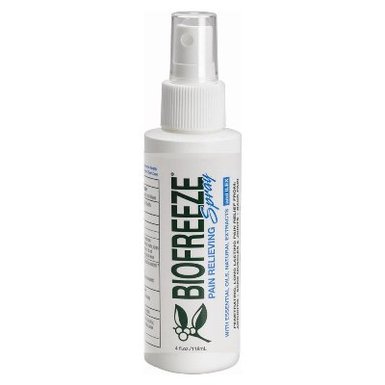BioFreeze Pain Relief Spray 2oz
Contour Living on 26th Oct 2014

Sorry, this item is no longer available
Small size for pain relief wherever you go! Biofreeze cold therapy pain relieving spray easily and deeply penetrates skin for fast relief of sore and strained muscles, arthritis pain and back aches. Handy 2 oz. spray bottle.
Check Out Our Topical Products
SMALL AND CONVENIENT BOTTLE FITS IN PURSE OR LUGGAGE!
Biofreeze spray is a topical pain reliever used in pain management programs to treat athletic and muscle-related injuries, sore and/or strained muscles, shoulder and amr discomfort, neck, hip & leg pain, painful joints, sports injury pain, ankle and foot pain and pain from arthritis. Biofreeze Pain Relieving Spray uses Menthol as the active ingredient. Reformulated in 2009, the spray formula also has the inactive ingredients MSM, Ilex and a new blend of botanical ingredients including: Arnica, Calendula, Chamomile, Echinacea, Juniper Berry, and White Tea. The spray is paraben free and dye free.
This formula provides improved performance and longer-lasting pain relief for those hard-to reach areas, such as the middle back and lower extremities.
BioFreeze Pain Relief BENEFITS
- Use for Penetrating, Long Lasting Pain Relief from Arthritis, Sore Muscles & Joints, Back Pain
- Spray is great for fast, easy application, especially in hard to reach areas like the back.
- Contains Menthol and Ilex, an all-natural herbal tea that has been used for centuries by Paraguay indians for enhancement of medicines
- Penetrates skin quickly and deeply
- Greaseless and non-staining; with a vanishing scent
- Use before, during, and after treatments to reduce pain and stiffness, enabling greater range of motion and flexibility
- Manufactured in the USA
How BioFreeze Works
Traditional thinking is that the pain-relieving mechanism of action of menthol - the active ingredient in Biofreeze Pain Reliever - results from a counter-irritant effect. Simply put, a counter-irritant has an effect of overriding noxious pain signals traveling to the brain through a process modulated between pain-transmitting and non-pain transmitting neurons. This process, known as "gate control" or "gating," was first described by Melzak and Wall.
Gate control theory is based on the understanding that pain is transmitted by two kinds of afferent nerve fibers. One is the larger myelinated A-delta fiber, which carries quick, intense-pain messages. The other is the smaller, unmyelinated "C" fiber, which transmits throbbing, chronic pain. A third type of nerve fiber, called A-beta, is "nonnociceptive," meaning it does not transmit pain stimuli. The gate control theory asserts that signals transmitted by the A-delta and C pain fibers can be thwarted by the activation/stimulation of the nonnociceptive A-beta fibers and thus inhibit an individual's perception of pain.
More recently, laboratory researchers have discovered that menthol stimulates the TRPM8 cold receptors. Even though it has long been accepted that cooling and cold can induce analgesia it has been a poorly understood mechanism. As scientists have continued to isolate these specific heat-sensitive transient receptor potential (TRP) channels within our sensory neurons we are now able to have a much better understanding of the body's cutaneous temperature detection. With the isolation and further study of these specific TRPM8 receptors there is stronger evidence supporting the benefits achieved with the cooling effect of menthol in functioning as a topical analgesic while activating these receptors and the resulting consequent pain relief.
